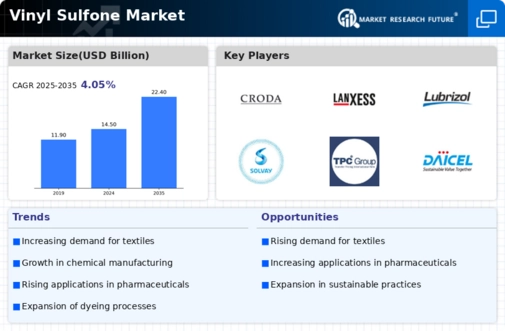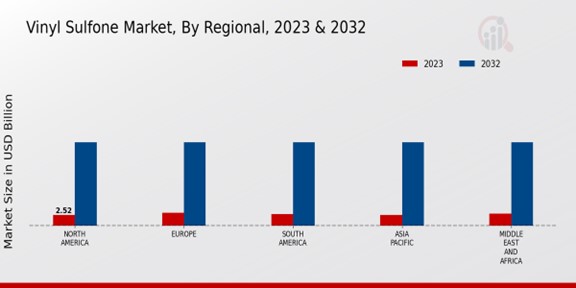Growing Demand in Textile Industry
The Global Vinyl Sulfone Market Industry experiences a notable surge in demand from the textile sector, primarily due to its application in dyeing processes. Vinyl sulfone compounds serve as reactive dyes, enhancing color fastness and overall fabric quality. As the global textile market is projected to reach approximately 1.5 trillion USD by 2024, the need for high-performance dyes is expected to rise. This trend is likely to drive the vinyl sulfone market, contributing to its anticipated growth to 14.5 USD billion in 2024. The increasing focus on sustainable and eco-friendly textile production further amplifies the relevance of vinyl sulfone in this sector.
Rising Applications in Agrochemicals
The Global Vinyl Sulfone Market Industry is witnessing a rise in applications within the agrochemical sector, where vinyl sulfone derivatives are utilized in the formulation of pesticides and herbicides. These compounds enhance the efficacy and stability of agrochemical products, making them essential for modern agricultural practices. As the global agrochemical market continues to expand, driven by the need for increased food production, the demand for vinyl sulfone is likely to grow. This trend aligns with the overall market growth, which is projected to reach 14.5 USD billion in 2024, reflecting the increasing importance of vinyl sulfone in agricultural applications.
Advancements in Chemical Manufacturing
The Global Vinyl Sulfone Market Industry benefits from advancements in chemical manufacturing technologies, which enhance the production efficiency and reduce costs associated with vinyl sulfone synthesis. Innovations such as continuous flow chemistry and green chemistry principles are being adopted, leading to more sustainable production processes. As manufacturers strive to meet the growing demand for vinyl sulfone in various applications, these technological improvements are likely to play a pivotal role. The market is projected to grow at a CAGR of 4.06% from 2025 to 2035, indicating a robust future for vinyl sulfone as a key chemical intermediate.
Expansion in the Pharmaceutical Sector
The Global Vinyl Sulfone Market Industry is significantly influenced by the pharmaceutical sector, where vinyl sulfone derivatives are utilized in the synthesis of various drugs. These compounds are crucial in developing active pharmaceutical ingredients (APIs) due to their reactivity and versatility. With the pharmaceutical market projected to grow substantially, reaching over 1.5 trillion USD by 2024, the demand for vinyl sulfone is expected to increase correspondingly. This growth trajectory suggests that the market could expand to 22.4 USD billion by 2035, driven by innovations in drug development and the increasing prevalence of chronic diseases.
Increasing Regulatory Support for Sustainable Chemicals
The Global Vinyl Sulfone Market Industry is positively impacted by increasing regulatory support for sustainable chemicals. Governments worldwide are implementing stricter regulations to promote environmentally friendly practices in chemical manufacturing. Vinyl sulfone, known for its lower environmental impact compared to traditional chemicals, is likely to benefit from this trend. As industries seek to comply with these regulations, the demand for vinyl sulfone is expected to rise. This regulatory landscape may contribute to the market's growth, potentially reaching 22.4 USD billion by 2035, as companies prioritize sustainability in their operations.












